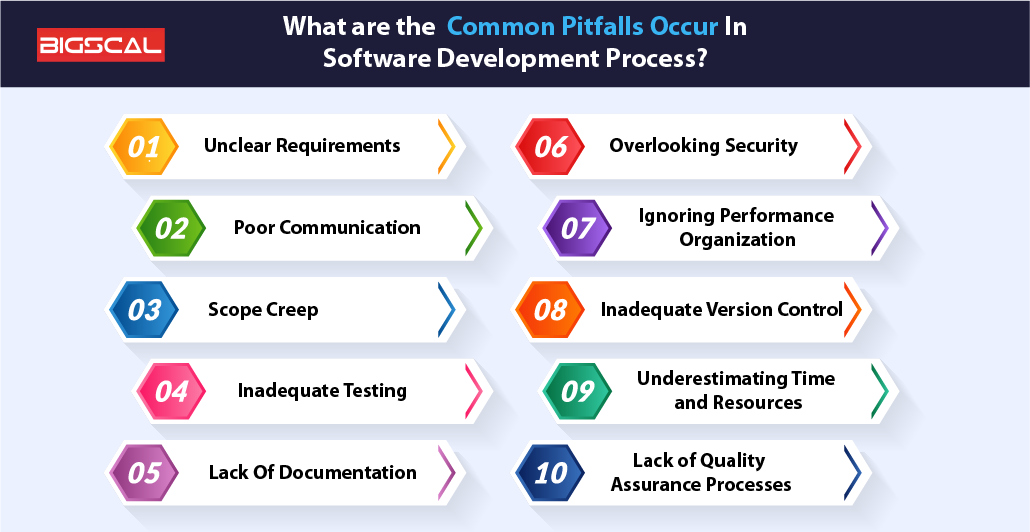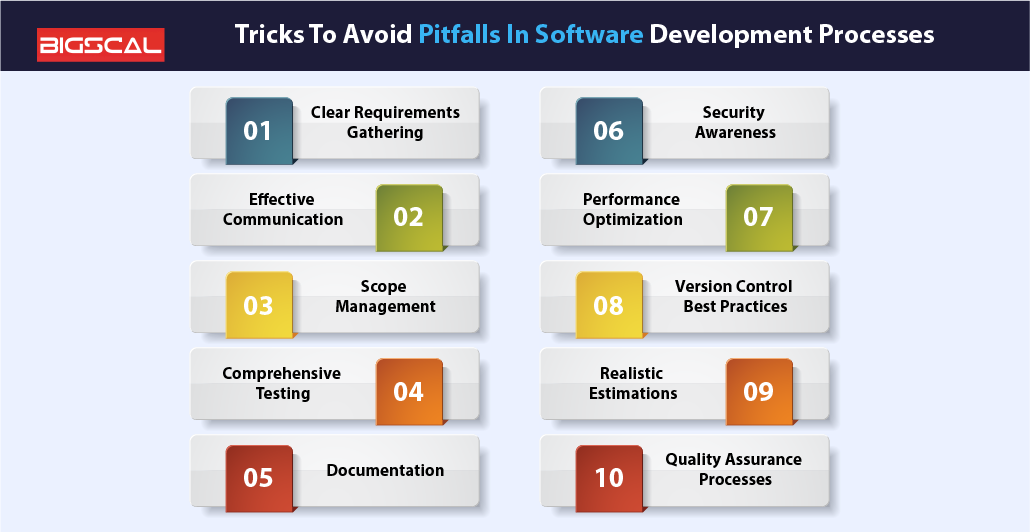10 Pitfalls To Sidestep In Modern Software Development
Quick Summary: For a successful completion of Modern Software Development you must Learn to sidestep common pitfalls. But how? and What are those pitfalls? We will tell you what are those common mistakes that you should avoid. Also we will discuss how you can avoid such issues. So, keep reading!
Introduction
To get done all your modern software development projects successfully you need to avoid embracing innovation and navigating potential pitfalls. As technology advances at breakneck speed, the journey from conception to deployment is riddled with challenges. This challenges can derail even the most meticulously planned projects. So, you must plan to avoid such challenges.
In this era of rapid iteration and continuous integration, developers must be vigilant to avoid common pitfalls. That can hinder progress, compromise quality, and inflate costs. You must not have overlook importance of thorough testing and underestimating the significance of user feedback.
There are more things you must aware of And we will help you on this!
We will Draw from real-world experiences and industry insights, we’ll delve into each pitfall. unraveling its complexities, and offering actionable strategies to mitigate its impact. Who ever you are, a software developer, or someone who has software solutions you want to develop the software. This blog will help you make your software development services better!
Why Is It Necessary To Avoid Pitfalls In The Modern Software Development Process?

Avoiding pitfalls in modern software development is essential for ensuring project success. To become the bеst software development company or software developers you must maintain a high standard of quality. Pitfalls, such as poor planning, inadequate testing, and ignoring security concerns, can lead to project delays, budget overruns, and compromised software integrity.
Thorough planning helps in setting clear objectives, timelines, and resource allocations, reducing the likelihood of scope creep and missed deadlines. Rigorous testing, including unit tests, integration tests, and user acceptance tests, helps uncover bugs early in software code, preventing costly fixes in later stages of development.
Moreover, addressing security concerns from the outset protects against data breaches and ensures compliance with regulatory requirements, safeguarding user trust and organizational reputation. By avoiding these pitfalls and adopting best practices throughout the development process, teams can deliver high-quality software products that meet user expectations and business needs effectively.
What are the Common Pitfalls Occur In Software Development Process?
Here are some types of software common pitfalls or mistakes that may occur during a modern software development life cycle, to understand how to avoid them you must know what are those common pitfalls. So, read them out:

Unclear Requirements
Uncertainty of requirements usually originates from the lack of a rigid understanding or dialog between stakeholders and development groups. If user needs are poorly explained or not defined clearly at all, it may lead to rework, misunderstandings and minimize usability value of the final product. The oil 305 of this pitfall during the software development process can be counteracted by allocating some time to gathering and documenting the task while using techniques like user stories, prototypes, communications and involve stakeholders.
Poor Communication
Inaccurate communication within the participants to the team or between different groups brings about delays, misunderstandings, and errors. Effective communication is established by each person playing a role in software development well knowing his/her roles and responsibilities they are assigned as well as they are able to communicate their expectations. A meeting schedule, easy routes for interaction, and collaboration- tools go quite a long way to ensure smoother communication.
Scope Creep
Scope creep describes the gradual uncontrollable alternation of the scope of a project leading it far out of the original framework. The change can be in accordance with the modifications of conditions, stakeholder calls, or incomplete planning. Prevention of what is termed scope creep is made possible by defining clear boundaries of the project, prioritizing features, and assessing and reaffirming such changes on a regular basis to the stakeholders.
Inadequate Testing
Inappropriate testing can cause an undetected flaw, security weakness and performance bug, and inconsiderate user interface. Checking up on application software should be as exhaustive as possible, with functional, performance, security, and usability being the primary scope of the attention. Use of automated testing tools and continuous integration can be the fine way to continuously test with a same quality level.
Lack Of Documentation
Inadequate documentation makes it difficult for developers to comprehend its codebase, to tackle issues relating to code, and to train newcomers. As software is designed, a documentation that provides design documents, API documentation, user manual, and comments of the codes is also need to go along with that. Regular updating and maintaining of the document is very necessary to keeping it up to date and useful for the lifecycle of the project at large for the relevant and useful purpose.
Overlooking Security
Security often takes a backseat in the rush to develop and deploy software. Failure to prioritize security can lead to severe consequences, including data breaches, compromised user information, and reputational damage. It’s crucial to incorporate security measures throughout the software development skills and process, such as secure coding practices, regular security audits, and robust authentication mechanisms, to mitigate risks effectively.
Ignoring Performance Organization
Neglecting performance optimization can result in sluggish and inefficient, software applications, leading to user frustration and dissatisfaction. Developers should pay attention to factors like code efficiency, database optimization, and resource utilization to ensure smooth and responsive software performance, particularly in applications handling large datasets or high user traffic.
Inadequate Version Control
Poor version control practices can lead to confusion, conflicts, and loss of valuable code changes· Implementing a reliable version control system, such system software such as Git, facilitates collaboration, tracks changes effectively, and enables easy rollbacks, ensuring project stability and continuity.
Underestimating Time and Resources
Underestimating the time and resources required for software development often leads to missed deadlines, budget overruns, and compromised quality· Thoroughly assessing project requirements, breaking tasks into manageable chunks, and allocating resources appropriately are essential for realistic project planning and execution by software engineers.
Lack of Quality Assurance Processes
Neglecting quality assurance processes can result in software defects, usability issues, and poor user experiences. Establishing QA procedures, including automated testing, code reviews, and user acceptance testing. It helps identify and rectify issues early in the software development lifecycle. Thus, ensures the delivery of high-quality, reliable software products.
Tricks To Avoid Pitfalls In Software Development Processes
Now, when you know about the pitfalls that may occur in modern software development, let’s understand how you can avoid them.

Clear Requirements Gathering
Conducting good requirements gathering stages during the software project work is of key significance. It assures that all stakeholders will perceive and endorse development project scope and objectives so well. This process implies extremely careful demonstration of the user’s needs. It also covers an area which consists of functionality, inconvenience, and expectation. The stakeholder engagement programs enable each one to be exposed to microfinancing concepts as early and frequently as possible. By implementing this approach, developers usually escape from misconceptions. Therefore, we are not confronted with extra expenses at the next working stages of the project.
Methods such as human interactions, surveys and prototyping support to elicit the total requirements fully. Moreover, utilizing tools like activity or workflow diagramming and requirement traceability can keep everything on the right track. The sequel story strategy to me includes the key of keeping the alignment throughout the story development. Crafting crystal clear requirements helps to establish a sound basis for efficient and effective project implementation. Beyond that it provides possibility to all of the team making solutions that satisfy the target audience and still save the tight budget and deadline.
Effective Communication
Effective networking is the turning of the wheel for successful software development projects. It implies a pattern of timely and open announcement of subjects and tasks that must be done by every team member. Frequent sessions, reports and reports highlight the same objectives and working together synchronously. It facilitates process of identifying problems and making data-driven decisions that are timely.
Employing communication tools that include project management systems. Use our AI to write for you about any topic! Enjoy Such as including chatting platforms, or live chats facilities, would make the process easy and accessible. It also creates uniform understanding and this implies the shared opinion by all. Not only do open communication cultures promote a culture of feedback, they stimulate team members’ creativity, and they are the foundation of ownership. The team can be able to avoid the confusion by concentrating on the simple and understandable communication. A great app would minimize the risks and work on producing top-notch items which cater to the customers’ needs and satisfaction.
Scope Management
Scope management in software development means to specify and include only tasks that are needed in a project and keep the rest out from the scope(definition,sight,boundary). It comes out with the point of fixing the borders of the projects in terms of the goals, results, features, and tasks. We can avoid a number of traps in the management of scope by the crafty and early definition of the scope and by tight monitoring and control of any additions or changes to the scope.
This measure will help to avoid this phenomenon of the so-called “scope creep” where a team is trying to add requirements without proper review of the project that ultimately results in delay, budget overruns, and the quality of the product. Creation of truly effective change control processes along with scoping reviews are some of the key measures we will undertake. Communication within team members has to be another important tool for the project team that helps in scope management and ensures clear communication among team members.
Comprehensive Testing
Extensive testing of software is the key activity of software development in its endeavor to localize and fix all bugs or errors in the software. It entails a process systematical passed to test every resources and functions in software with the aim to discover the defects in a way that software will fulfill the requirement form users and work based on expected. In order to trap testing failures, it is important to test using various testing that constitute unit testing, integration testing, system testing, and user acceptance testing.
Other than that, using such automation tools will enable you to revise the testing process, cover more areas, and finally perfect the quality of the code to the best of your abilities. Identifying the testing activities taking into account risk assessment, carrying out comprehensive regression testing after the code changes, and engaging stakeholders in the testing activities will consume the activities of testing in more general and consequential way.
Documentation
Software documentation provides the project clarity, consistency, and continuity ensure these features throughout the lifecycle of the project for clear understanding. It acts as a complete and consistent reference point for the developers and future maintainers as well as stakeholders to work on. Documentation is a broad way to view documentation. For example, it describes the project requirements, architecture, design solutions, code arrangements, programming languages, and API interfaces. Renewed opportunities for individuals to become their own boss by running these micro-businesses can also be created by documenting these aspects. Teams can effectively minimize uncertainty caused by loss of vital knowledge, staff changes, and lack of communication through teamwork.
Moreover, well-documented code facilitates easier debugging, troubleshooting, and scalability. Utilizing tools such as code comments, README files, and wiki pages streamlines the documentation process and ensures accessibility for all team members. Regular updates and version control mechanisms further enhance the reliability and relevance of documentation. It empowers teams to navigate complex software landscapes with confidence and efficiency.
Security Awareness
In today’s interconnected digital landscape, security awareness is paramount in software development· It involves educating team members about potential vulnerabilities, threats, and best practices to safeguard sensitive data and systems. By fostering a culture of security consciousness, organizations can proactively address security concerns throughout the development lifecycle. This includes implementing secure coding practices, conducting regular security audits, and staying informed about emerging threats and compliance regulations.
Integrating security testing tools and techniques into the development pipeline helps identify and remediate vulnerabilities early on, reducing the likelihood of costly breaches and reputational damage. Additionally, promoting collaboration between developers, security experts, and stakeholders fosters a proactive approach to addressing security challenges. It ensures that security remains a top priority at every stage of the software development process.
Performance Optimization
Performance optimization in software development aims to enhance the efficiency and speed of a system or application. This process involves identifying and rectifying bottlenecks that may hinder operating systems optimal performance. It involves using Strategies for optimization include code refactoring, algorithmic improvements, database optimizations, and resource management. Profiling tools help developers pinpoint areas of code that consume the most resources or experience performance degradation.
Techniques such as caching, lazy loading, and asynchronous processing can also improve performance. Continuous monitoring and testing are crucial to ensure that optimizations do not introduce new issues. Moreover, performance optimization is an ongoing effort that requires a deep understanding of the application’s architecture. It also includes the ability to balance speed with other considerations such as maintainability and scalability.
Version Control Best Practices
Version control is essential for managing changes to code and collaborating with other developers effectively. Best practices include using descriptive commit messages, branching for feature development and bug fixes. And regularly pulling changes from the main repository to stay up-to-date. Utilizing a centralized version control system like Git allows for easy collaboration and tracking of changes over time.
Branches should be kept small and focused to facilitate easier code reviews and merging. It’s also important to adhere to a consistent workflow, whether it’s Gitflow, GitHub flow, or another methods. Additionally, implementing access controls and permissions ensures that only authorized individuals can make changes to the codebase. By following version control best practices, teams can maintain a clean, organized codebase and streamline the development process.
Realistic Estimations
Realistic estimations are crucial in software development as they set the foundation for project planning and execution. Developers must assess the complexity of tasks, considering factors like requirements clarity, team expertise, and potential risks. Overly optimistic estimates often lead to missed deadlines and project delays. While excessively conservative ones may hinder resource allocation and client expectations·
To achieve realistic estimations, teams should leverage historical data. They must break down tasks into smaller, manageable units. Additionally, they should involve relevant stakeholders for input, and continuously refine estimates as the project progresses. By embracing transparency and honesty in estimations, teams can foster trust with clients and stakeholders. Hence, it ensures smoother project execution and successful outcomes.
Quality Assurance Processes
Quality assurance processes are integral to delivering software that meets user needs and industry standards. These processes encompass various activities. These are code reviews, bug tracking and testing. They identify and rectify defects throughout the development lifecycle. By implementing quality assurance measures, teams can mitigate the risk. Hence they can deliver the flawless software, thereby enhancing user satisfaction and brand reputation.
Quality assurance also involves adhering to coding standards. It also involves performing regression testing, and soliciting feedback from end-users to continuously improve product quality. Moreover, prioritizing quality assurance create a culture of excellence within development teams. It drives efficiency, reliability, and customer loyalty in software products and services.
Develop Flawless Software With Bigscal Technologies
Bigscal Technologies specializes in developing flawless software solutions. Additionally, it is basically a custom software development company. Thus, we build custom solutions that fit with the unique needs of businesses across all industries. We have a proven track record of delivering high-quality software products. Furthermore, we combine cutting-edge technologies with industry best practices to ensure optimal performance, scalability, and security.
We do meticulous planning, thorough analysis, and agile methodologies to adapt. It helps us to evolve requirements seamlessly for the development process. Our team of experienced software engineers and designers work closely with clients to understand their vision.
Through continuous communication and collaboration, Bigscal ensures client’s involvement. It fosters transparency and trust. Rigorous testing procedures guarantee the reliability and robustness of the software. And post-deployment support ensures smooth operation and user satisfaction.
Partnering with Bigscal Technologies guarantees businesses access to top-notch software solutions. These solutions are flawless. They also empower you to stay ahead in today’s competitive digital pace.
Conclusion
Now when you know about the pitfalls in modern software development. And also know how you can get rid of them all. Recognizing and addressing these pitfalls early empowers development teams to deliver high-quality software. It also helps to deliver products that meet user needs and exceed expectations in today’s dynamic digital landscape. So, all you need to do is implement these strategies to make your project successful.
FAQ
What are the top 3 reasons a software project fails?
- Poor communication
- Inadequate planning
- Unrealistic expectations
What is the biggest challenge that you have faced in your career as a software developer?
Adapting to rapidly evolving technologies and methodologies. With that it also maintains a balance between delivering quality products and meeting tight deadlines has been my biggest challenge as a software developer.
What is a common pitfall in application development?
A common pitfall in application development is neglecting quality assurance and proper testing. It leads to undetected bugs, security vulnerabilities, and user dissatisfaction post-deployment.
What are the four major issues in software?
- Correctness
- Reliability
- Efficiency
- Maintainability
Why do SW projects fail?
The project fail because of various reasons which are:
- Poor Planning
- Inadequate Resources
- Technical Challenges
- Poor Quality Assurance
- Misalignment with Business Needs
- Lack of Communication
- External Factors
- Scope Creep







